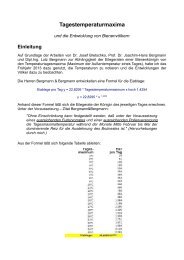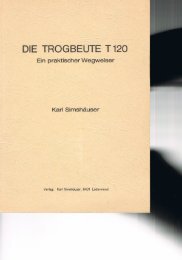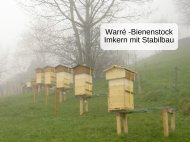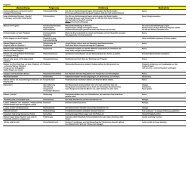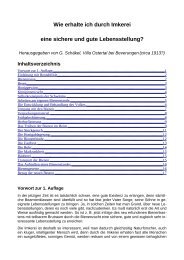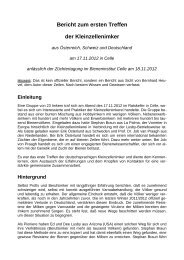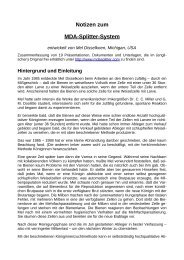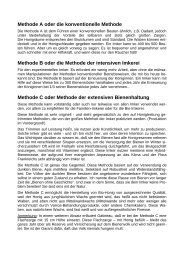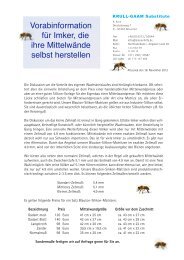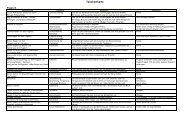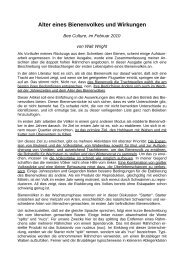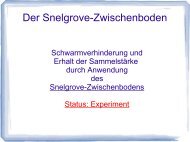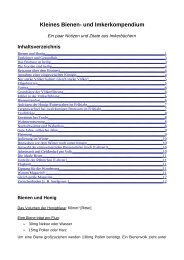Two-queen colony management - Immenfreunde
Two-queen colony management - Immenfreunde
Two-queen colony management - Immenfreunde
Create successful ePaper yourself
Turn your PDF publications into a flip-book with our unique Google optimized e-Paper software.
Instructions<br />
<strong>Two</strong>-<strong>queen</strong> <strong>colony</strong> <strong>management</strong><br />
C.L: Farrar, 1946<br />
A strong <strong>colony</strong> is first divided temporarily into two <strong>colony</strong> units for the purpose of introducing the<br />
second <strong>queen</strong>. The old <strong>queen</strong> is confined to the lower brood chamber with an excluder. This<br />
chamber should contain reserve honey and pollen, half the brood (mostly eggs and larvae), and<br />
approximately 40 percent of the population. <strong>Two</strong> supers of drawn comb are added above the<br />
excluder. The inner cover, with the escape hole screened, is placed above these supers and the the<br />
upper brood nest placed on top. The upper brood chamber should contain approximately 60 percent<br />
of the original population. Some of the bees will drift back to the lower entrance, but this division<br />
tends to give a fairly equal balance to the two <strong>colony</strong> units. The more mature brood is used in the<br />
upper unit, because fewer bees will be required to protect this brood, and the division will be<br />
strengthened by emerging bees. A 1-inch auger hole just below the front handhold provides an<br />
entrance for the upper <strong>colony</strong>.<br />
The young <strong>queen</strong> may be introduced by any of the customary methods. The rearing of a <strong>queen</strong> from<br />
<strong>queen</strong> cells in the division results in loss of valuable brood-rearing time. The new <strong>queen</strong> may be<br />
introduced by mailing-cage method, but the losses that usually result tend to offset the advantage of<br />
it's simplicity. The direct introduction of laying <strong>queen</strong>s from nuclei has proved the most successful<br />
method under all conditions.<br />
From 7 to 10 days before the divisions are made, <strong>queen</strong>s from the South should be sprayed into<br />
small nuclei to provide the laying <strong>queen</strong>s. Three <strong>queen</strong>s can be purchased with each 2-pound<br />
package, or the <strong>queen</strong>s alone may be obtained and introduced to package bees shaken from the<br />
stronger overwintered colonies. [...] When uniting these bees to the nucleus in the absense of a<br />
honey flow, the operator should spray both units with sugar sirup.<br />
When laying <strong>queen</strong>s are available in nuclei, a <strong>queen</strong> with her brood and bees is united by the spray<br />
method to the upper unit when the clony is divided. Queen acceptance is nearly 100 percent, and<br />
both <strong>queen</strong>s continue egg laying without interruption. The nuclei may be restocked to provide<br />
replacement <strong>queen</strong>s. Queens that show up poorly in the nuclei should not be introduced to<br />
producing colonies.<br />
As soon as the top <strong>queen</strong> has a well-established brood nest, usually 10 to 14 days after<br />
introduction, the screened inner cover can be removed. In this uniting of the two colonies, the bees<br />
in both brood nests should be sprayed with sirup. The upper <strong>queen</strong> may require a second set of<br />
brood combs at this time, thus making the <strong>colony</strong> five stories high. Both upper brood chambers<br />
should have augerhole entrances. The upper and lower brood nest must both have reserve honey<br />
and pollen even after uniting. Brood rearing may suffer or the bees may starve in one, even though<br />
the other has plenty of food.<br />
As the <strong>colony</strong> populations increase and room is required for honey storage, the organisation<br />
diagrammed in figure 2c, should be maintained. Ten standard combs provide plenty of space for a<br />
good <strong>queen</strong> in the lower brood nest, as very little honey is stored here. Supers in position 2 and 3<br />
should never be allowed to become more than half filled with honey. Too much honey here will<br />
cause the lower brood nest to become honey bound and the hive will operate as two seperate<br />
colonies. When these supers become partially filled with honey, they should be raised above the<br />
upper brood nest and replaced by empty supers. The position of the two chambers used for the<br />
upper brood nest should be interchanged at each manipulation, the heaviest chamber and most of<br />
the immature brood being placed in the fourth position with the sealed and emerging brood in the
fifth.<br />
Honey storage commences within and above the upper brood nest. The lower <strong>colony</strong> tends to<br />
supply bees to the upper one, where honey storage is dominant. Most of the <strong>colony</strong>'s flight activity<br />
may be through the auger holes of the upper brood chambers. Frequent interchanging of the upper<br />
brood chambers permits the <strong>queen</strong> to expand her brood nest upward, where she can use the space<br />
made available by emerging bees. It also stimulates the removal of considerable honey surrounding<br />
the young brood put down, thus making more space available for the <strong>queen</strong> when the brood<br />
chambers are again interchanged. The movement of ripened honey from the brood nest hastens the<br />
finishing of the supers so they can be extracted and returned for refilling.<br />
During a good honey flow the <strong>colony</strong> must be manipulated every 6 to 8 days to maintain the<br />
optimum organization as diagrammed in figure 2c. Supers with empty combs from which the honey<br />
has been extracted are placed between the two brood nests. Those containing some honey in<br />
positions 2 and 3 are placed above the upper brood nest for finishing. During heavy honey flows,<br />
especially when the nectar is thin, one or two additional supers may be needed above the upper<br />
brood nest to keep the supers in positions 2 and 3 comparatively free of honey.<br />
Colonies should be united back to single-<strong>queen</strong> status approximately 4 weeks prior to the expected<br />
end of the flow. It is seldom necessary to locate the <strong>queen</strong>s. The upper <strong>queen</strong> usually survives, but<br />
if the lower one does, it is likely that she is the better individual. With three brood chambers at the<br />
disposal of the surviving <strong>queen</strong>, manipulation is seldom necessary for the remainder of the season.<br />
Super space should be provided generously. These double colonies may make daily gain 20 to 30<br />
pounds under flows that permit single-<strong>queen</strong> colonies to gain 8 to 12 pounds. Plenty of space is<br />
needed for this incoming nectar in addition to that required for storing honey. Combs should be<br />
extracted and the super returned for refilling as soon as they are finished. The use of shallow<br />
equipment hastens the finishing of supers so that space can be provided when and where it is most<br />
needed.<br />
When colonies are united to a single-<strong>queen</strong> status, they build up pollen reserves rapidly if pollen is<br />
available in the field. They have the population of two colonies and the brood of only one <strong>queen</strong>. For<br />
the same reason honey storage is at the most efficient level for the number of bees in the <strong>colony</strong>.<br />
When the supers are removed at the close of the season, the <strong>colony</strong> should be left in three stories<br />
for overwintering. The three story <strong>colony</strong> should contain 80 or more pounds of honey and as much<br />
pollen as possible. In standard equipment such a <strong>colony</strong> should have a gross weight of at least 175<br />
pounds. Colonies may not use all of the reserve honey, but this practice provides the best insurance<br />
that the colonies will be ready for the next honey flow. Honey that is not consumed will add to the<br />
next year's honey crop by reducing the amount required to build up the reserve.<br />
The mechanics of two-<strong>queen</strong> <strong>colony</strong> manipulation<br />
It is essential that the hive stands be level and situated on firm ground. The bottom boards should<br />
be close to the ground. <strong>Two</strong>-<strong>queen</strong> colonies can be manipulated more easily if two man work<br />
together. After the bees at the entrances have been smoked and the metal cover has been<br />
removed, the hive, supported by a man on each side, can be tipped over backwards and worked in<br />
a horizontal position. The propolis will prevent the hive bodies from slipping, even while the heavy<br />
seven- to nine-story hives are lowered to the ground.<br />
The top brood nest should immediately be seperated from the supers above and below it to prevent<br />
the <strong>queen</strong> from leaving the brood chambers. To reassemble the hive, the bottom board is placed on<br />
the hive stand. A glance beneath the lower brood nest before it is put in place is usually sufficient to<br />
see wether everything is normal. If the intervening supers contain considerable honey, one or two<br />
empty supers should be added before placing the heaviest brood chamber from the upper brood<br />
nest. This should have considerable unsealed brood in five to six frames. The upper brood chamber
must provide room for the <strong>queen</strong> to lay, either empty comb or frames of emerging brood. The first<br />
two supers above the upper brood nest should not be more than one-third to one-half full. When<br />
necessary to provide additional room, an empty super should be added on top.<br />
Working the hives in a horizontal position does not eliminate the necessity of lifting the hive bodies<br />
back into position. However, it does reduce the labor of manipulation. The upper <strong>queen</strong> is less likely<br />
to run into the supers, and the bees are more gentle. The returning field bees are confused and<br />
offer little resistance. Those in the top hive bodies are not driven down into the lower part of the<br />
hive, where they would later be disturbed under a disorganised and congested condition. Illtempered<br />
bees are usually encountered in the lower part of the hive when working from the top<br />
down.<br />
The use of <strong>queen</strong> excluders and foundation<br />
A <strong>queen</strong> excluder over the lower brood nest is a necessity. Another <strong>queen</strong> excluder below the upper<br />
brood nest will prevent the upper <strong>queen</strong> from running down into the intervening supers when the<br />
<strong>colony</strong> is manipulated. Its use saves time in hive manipulation because the operator knows the<br />
location of the upper <strong>queen</strong>. A third excluder over the upper brood nest may be used to advantage<br />
under some conditions, but it tends to force more honey into the brood nest.<br />
The upper <strong>queen</strong> can be maintained in her proper position without excluders by the timely rotation<br />
of the brood chambers. Most of the mature brood is placed above to provide space for the <strong>queen</strong> to<br />
expand her brood nest normally upward.<br />
<strong>Two</strong>-<strong>queen</strong> colonies can be handled most satisfactorily when drawn combs are available for both<br />
brood chambers and supers. During the main honey flow, foundation can be drawn between the two<br />
brood nests. Only the lower <strong>queen</strong> should be restricted with an excluder when the supers contain<br />
foundation. The use of foundation sometimes forces so much honey into the upper brood nest that<br />
empty combs must be substituted for those filled with honey in order to give the <strong>queen</strong> room.<br />
Queen supersedure, replacements, swarming and increase<br />
The problem of supersedure is no greater in two-<strong>queen</strong> than in single-<strong>queen</strong> colonies except that,<br />
when one <strong>queen</strong> is poor and <strong>queen</strong> cells are started, cells usually will be built in the other brood<br />
nest.<br />
When a new <strong>queen</strong> is introduced to either brood nest, the two nests must be completely separated,<br />
as when the original division is made. After all <strong>queen</strong> cells have been removed, a nucleus with a<br />
good laying <strong>queen</strong> may be united by the spray method. If there is a honey flow, the screened inner<br />
cover can be exchanged for a <strong>queen</strong> excluder at the next manipulation without spraying the bees.<br />
Swarming is not a problem when good <strong>queen</strong>s are maintained in both brood nests, and space for<br />
brood expansion and honey storage is provided by timely manipulations. Since the two-<strong>queen</strong> may<br />
25 to 30 pounds of bees, a great loss will result if the <strong>colony</strong> is allowed to swarm. The wings of both<br />
<strong>queen</strong>s should be clipped. If the <strong>colony</strong> attempts a swarm, both <strong>queen</strong>s may be found in the lower<br />
brood nest. One of the <strong>queen</strong>s may be returned to the upper brood nest when the conditions that<br />
caused swarming have been corrected. However, when the <strong>queen</strong>s are shrunken, the drastic<br />
treatment of making a "shook-swarm" with one of the <strong>queen</strong>s on a new set of combs probably is<br />
best. The other <strong>queen</strong>, with all the brood and adhering bees, can be set to one side to allow many<br />
of the bees to drift back to the original hive location. When both <strong>queen</strong>s are laying normally, the<br />
hives can be recombined in a manner suitable to the honey flow.<br />
Increase from two-<strong>queen</strong> colonies is not generally recommended, because the advantage of large<br />
pollen reserves for wintering strong colonies may be lost. If other single-<strong>queen</strong> colonies are storing<br />
large pollen reserves, the two-<strong>queen</strong> organisation can be retained until the end of the honey flow<br />
instead of uniting back to a single-<strong>queen</strong> status. They may be wintered as double colonies by
emoving the lower <strong>queen</strong> excluder and placing a super of honey in dark combs above the lower<br />
brood nest. A moving screen is placed above this, and the upper brood nest set on the screen. The<br />
double <strong>colony</strong> is wintered in four bodies, with the lower half given a reduced bottomboard entrance<br />
and the upper half only the auger-hole entrance in the top chamber. A commercial operation who<br />
has used this plan successfully during several seasons believes that less honey is required than<br />
when the colonies are maintained separately. His bees have had abundant pollen reserves, and<br />
both the upper and lower colonies have wintered strong.<br />
Weak colonies in the spring may be set above good colonies in the manner used to organise twocolonies<br />
by division. An excluder is used beneath the weak <strong>colony</strong> in place of the inner cover. The<br />
bees of both colonies should be sprayed with sugar sirup when they are set together. If the weak<br />
<strong>colony</strong> has a good <strong>queen</strong>, the bees that move up from the lower <strong>colony</strong> will enable her to expand<br />
brood rearing. If it has a poor <strong>queen</strong>, nothing is lost as would be the case where the brood or bees<br />
from a good <strong>colony</strong> are taken to strengthen a weak one.<br />
Summary<br />
<strong>Two</strong>-<strong>queen</strong> <strong>management</strong> is based upon the principle that the production per unit number of bees<br />
increases as the population is increased. <strong>Two</strong>-<strong>queen</strong> colonies have two chances of remaining<br />
<strong>queen</strong>-right, which under commercial <strong>management</strong> practically eliminates all non-producing colonies<br />
due to <strong>queen</strong> failure. Colonies are overwintered with young <strong>queen</strong>s and the beekeepers' attention is<br />
focused on <strong>queen</strong> quality at all times. The larger pollen reserves accumulated after the colonies<br />
have been reduced to a single-<strong>queen</strong> status make it possible to overwinter strong colonies for the<br />
next season.<br />
Less equipment is used in producing a given crop of honey than is customary under single-<strong>queen</strong><br />
<strong>management</strong>. However, there are some limitations to the use of standard hive equipment for two<strong>queen</strong><br />
colonies.<br />
The height of fully equipped two-<strong>queen</strong> colonies, requires two operators for their efficient<br />
<strong>management</strong>. Approximately 50 percent more labor is required per <strong>colony</strong> but less labor per pound<br />
of honey produced. Close timing of manipulations is essential to meet the two-<strong>queen</strong> <strong>colony</strong><br />
requirements, but this is equally important for the efficient <strong>management</strong> of any colonies.
Abbildung 4: Teilung der<br />
Brutzarge, Einsetzen der 2.<br />
Königin<br />
Abbildung 1: Zargenwechsel im Frühjahr<br />
Abbildung 3: Anordnung der<br />
zwei Königinnen vor und<br />
während der Honigtracht/der<br />
Saison<br />
Abbildung 2: Reduzierung<br />
auf eine Königin in den<br />
letzten 4 Wochen der<br />
Honigtracht/Saison



